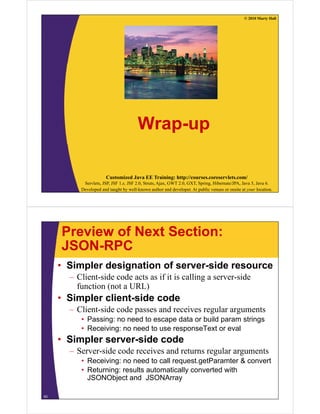Automatically generating-json-from-java-objects-java-objects268
- 1. © 2010 Marty Hall Automatically Generating JSON from Java Objects Originals of Slides and Source Code for Examples: http://courses.coreservlets.com/Course Materials/ajax.html http://courses.coreservlets.com/Course-Materials/ajax.html Customized Java EE Training: http://courses.coreservlets.com/ Servlets, JSP, JSF 1.x, JSF 2.0, Struts, Ajax, GWT 2.0, GXT, Spring, Hibernate/JPA, Java 5, Java 6. Developed and taught by well-known author and developer. At public venues or onsite at your location. © 2010 Marty Hall For live Ajax & GWT training, see training courses at http://courses.coreservlets.com/. t htt // l t / Taught by the author of Core Servlets and JSP, More Servlets and JSP and this tutorial. Available at JSP, tutorial public venues, or customized versions can be held on-site at your organization. •C Courses d developed and t l d d taught b M t H ll ht by Marty Hall – Java 6, servlets/JSP (intermediate and advanced), Struts, JSF 1.x, JSF 2.0, Ajax, GWT 2.0 (with GXT), custom mix of topics – Ajax courses can concentrate on 1EE Training: http://courses.coreservlets.com/ or survey several Customized Java library (jQuery, Prototype/Scriptaculous, Ext-JS, Dojo, Google Closure) • Courses developed and taught by coreservlets.com experts (edited by Marty) Servlets, JSP, JSF 1.x, JSF 2.0, Struts, Ajax, GWT 2.0, GXT, Spring, Hibernate/JPA, Java 5, Java 6. – Spring, Hibernate/JPA, EJB3, Web Services, Ruby/Rails Developed and taught by well-known author and developer. At public venues or onsite at your location. Contact [email protected] for details
- 2. Topics in This Section • Using org.json Java utilities – Building JSON object from bean – Building JSON array from Java array or List – Building JSON object from Map – Other JSON-generation utilities • Using json2.js JavaScript utilities – Sending JSON objects to server 4 © 2010 Marty Hall Intro and Setup Customized Java EE Training: http://courses.coreservlets.com/ Servlets, JSP, JSF 1.x, JSF 2.0, Struts, Ajax, GWT 2.0, GXT, Spring, Hibernate/JPA, Java 5, Java 6. Developed and taught by well-known author and developer. At public venues or onsite at your location.
- 3. Using MVC to Build JSON • Last section: used MVC to build JSON – Advantages • Requires no special server software • You have full control over result – Disadvantages • Tedious for complex data structures • Oft requires knowledge of how server will use data Often i k l d fh ill d t • This section: turning Java into JSON – Advantages • Can generate complex data easily • Builds real objects so server can decide what to do – Di d Disadvantages • Requires JSON-specific server software 6 • Sometimes builds objects with unneeded data in them Installing the org.json.* Utilities • Download – http://www.json.org/java/json.zip • Or start at http://www.json.org/java/ and follow link that says “Free source code is available”. y • Install – Unzip to get org/json/*.java – Put into src folder of Eclipse • Create new package org.json, then copy files there – They do not supply a JAR file but you could easily build file, one yourself, then put JAR file in WEB-INF/lib • Built org.json-utils.jar and put online at coreservlets.com • Documentation – http://www.json.org/java/ 7
- 4. Configuring Eclipse Project Used only in last example. Available for download at http://www.json.org/json2.js. You can also get compressed version; see http://www.json.org/js.html. Used in all examples. Available for download at http://courses.coreservlets.com/Course-Materials/ajax.html http://courses coreservlets com/Course-Materials/ajax html Downloaded latest .java files from http://www.json.org/java/, compiled, and put resultant .class files in JAR file. Or, you can put .java files from http://www.json.org/java/ directly in src/org.json. 8 Other JSON-Generation Software • org.json utilities (used in this tutorial) – Wid l used Widely d • Used within other utilities (e.g., JSON-RPC) – Limited power • Alt Alternatives ti – Google Gson • Better support for generics • htt // d http://code.google.com/p/google-gson/ l / / l / – JSON Taglib • More usable directly from JSP • http://json taglib sourceforge net/ http://json-taglib.sourceforge.net/ – VRaptor • Uses annotations for much of the work • http://vraptor org/ajax html http://vraptor.org/ajax.html – Many more • See “Java” entry at http://json.org/ 9
- 5. © 2010 Marty Hall Supporting Java Code (Used in All Examples) Customized Java EE Training: http://courses.coreservlets.com/ Servlets, JSP, JSF 1.x, JSF 2.0, Struts, Ajax, GWT 2.0, GXT, Spring, Hibernate/JPA, Java 5, Java 6. Developed and taught by well-known author and developer. At public venues or onsite at your location. Main Bean: City.java • Constructor public City(String name, int timeZone, int pop) { setName(name); setTimeZone(timeZone); setPop(pop); } • Getter methods – getName – getTime, getTimeZone • Assumes server is in US east coasts subtracts 0-3 hours coasts, 03 based on time zone – getPop • Raw population as an int – getPopulation 11 • Formatted population as a String with commas
- 6. Utilities for Finding Beans: CityUtils.java CityUtils java • Map that associates city name with City private static Map<String,City> biggestAmericanCities = new HashMap<String,City>(); • Populate it with largest US cities • L k Lookup f functions ti public static City getCity(String name) { name = name.toUpperCase(); return(biggestAmericanCities.get(name)); } 12 Utilities for Finding Beans: CityUtils.java CityUtils java Continued • Map that associates category of cities with city names i private static Map<String,String[]> cityTypeMap; • Lookup function public static List<City> findCities(String cityType) { String[] cityNames = cityTypeMap get(cityType); cityTypeMap.get(cityType); if (cityNames == null) { String[] twoCities = { "New York", "Los Angeles" }; cityNames = twoCities; } List<City> cities = new ArrayList<City>(); for(String cityName: cityNames) { cities.add(getCity(cityName)); cities add(getCity(cityName)); } return(cities); 13 }
- 7. Parent Servlet Class: ShowCities.java ShowCities java public abstract class ShowCities extends HttpServlet { public void doGet(HttpServletRequest request, HttpServletResponse response) throws ServletException, IOException { response.setHeader("Cache-Control", "no-cache"); response.setHeader("Pragma", "no-cache"); response.setContentType("text/javascript"); List<City> cities = getCities(request); outputCities(cities, request, response); } protected List<City> getCities(HttpServletRequest request) { String cityType = request.getParameter("cityType"); return(CityUtils.findCities(cityType)); } 14 Parent Servlet Class: ShowCities.java ShowCities java Continued public void doPost(HttpServletRequest request, HttpServletResponse response) throws ServletException, IOException { doGet(request, response); } public abstract void outputCities (List<City> cities, HttpServletRequest request, HttpServletResponse response) throws ServletException, IOException; } 15
- 8. © 2010 Marty Hall General Approach Customized Java EE Training: http://courses.coreservlets.com/ Servlets, JSP, JSF 1.x, JSF 2.0, Struts, Ajax, GWT 2.0, GXT, Spring, Hibernate/JPA, Java 5, Java 6. Developed and taught by well-known author and developer. At public venues or onsite at your location. Steps for Servlet Using JSON Utilities • Set normal response headers – response.setHeader f P tH d for Pragma and C h C t l d Cache-Control • Set Content-Type to text/javascript – response.setContentType("text/javascript"); • Get PrintWriter in normal manner – PrintWriter out = response.getWriter • Get result as bean array or Map bean, array, – Call normal business logic code • Turn Java object into JSONObject – JSONObject result = new JSONObject(bean); – JSONArray result = new JSONArray(arrayOfBeans, false); – JSONObject result = new JSONObject(map); j j ( p) • Output JSONObject with print – out.print(result); 17
- 9. Steps for Using JSON Utilities: Sample Servlet Code public void doPost(HttpServletRequest request, HttpServletResponse response) throws ServletException, IOException { response.setHeader("Cache-Control", "no-cache"); response.setHeader("Pragma", "no-cache"); response.setContentType("text/javascript"); PrintWriter out = response.getWriter(); SomeBean javaResult = callSomeBusinessLogic(…); JSONObject jsonResult = new JSONObject(javaResult); p (j ); out.print(jsonResult); } These two lines are the only ones that typically change from application t application. Oth li f li ti to li ti Other lines stay exactly as iis. t tl 18 © 2010 Marty Hall Turning Java Beans j into JSONObject Customized Java EE Training: http://courses.coreservlets.com/ Servlets, JSP, JSF 1.x, JSF 2.0, Struts, Ajax, GWT 2.0, GXT, Spring, Hibernate/JPA, Java 5, Java 6. Developed and taught by well-known author and developer. At public venues or onsite at your location.
- 10. Turning Beans into JSON • org.json defines JSONObject – I toString method builds JSON f Its S i h d b ild format • Most important constructor takes a bean – JSONObject json = new JSONObject(myBean); • Second arg of “true” means to include superclass info – Result • Uses reflection on myBean to find all public methods of the form getBlah (any return type) or isBlah (boolean return) • Calls each getter method • If myBean has getFoo and getBar, it builds object of the form { "foo": "getFoo() result", "bar": "getBar() result"} • Other capabilities – Can turn Map into JSONObject (keys become properties) – Can add properties one at a time with “put” 20 JSONObject from Bean: Example Code package coreservlets; import org.json.*; public class CityTest1 { public static void main(String[] args) { City sf = CityUtils.getCity("San Francisco"); JSONObject fJSON JSONObj t sfJSON = new JSONObj t( f) JSONObject(sf); System.out.println("JSON version of SF is:n" + sfJSON); } } Note: toString is automatically called when you print an Object in Java. It is the toString method of JSONObject that builds the JSON representation. 21
- 11. JSONObject from Bean: Example Result JSON version of SF is: {"time": "06:00:55 AM" AM", "name": "San Francisco", "timeZone": -3, "pop": 744041, "population": " 744,041"} • (White space added for readability) 22 Building Arrays of JSON Info • org.json defines JSONArray – Its toString method outputs array in JSON format • Most important constructors – new JSONA JSONArray(javaArrayOrCollection) (j A O C ll i ) • Assumes javaArrayOrCollection contains primitives, Strings, or JSONObjects – new JSONArray(javaArrayOrCollection, false) • Assumes javaArrayOrCollection contains beans that should be converted as in previous section, but you don’t p , y want to include superclass info – new JSONArray(javaArrayOrCollection, true) • Assumes javaArrayOrCollection contains beans that should be converted as in previous section, but you do want to include superclass info 23
- 12. JSONArray: Example Code package coreservlets; import org.json.*; import java.util.*; public class CityTest2 { public static void main(String[] args) { List<City> biggestUSCities = CityUtils.findCities("top-5-cities"); JSONArray citiesJSON = new JSONArray(biggestUSCities, false); e JSO ay(b ggestUSC t es, a se); System.out.println("JSON version of biggest " + "US cities is:n" + ); citiesJSON); } } 24 JSONArray: Example Result JSON version of biggest US cities is: [{"time":"09:14:16 AM" "name":"New York" AM", York", "timeZone":0,"pop":8250567,"population":"8,250,567"}, {"time":"06:14:16 AM", "name":"Los Angeles", "timeZone":-3,"pop":3849368,"population":"3,849,368"}, "timeZone": 3 "pop":3849368 "population":"3 849 368"} {"time":"08:14:16 AM", "name":"Chicago", "timeZone":-1,"pop":2873326,"population":"2,873,326"}, {"time":"08:14:16 AM", " {"ti " "08 14 16 AM" "name":"Houston", " "H t " "timeZone":-1,"pop":2144491,"population":"2,144,491"}, {"time":"07:14:16 AM", "name":"Phoenix", "timeZone":-2,"pop":1512986,"population":"1,512,986"}] "ti Z " 2 " " 1512986 " l ti " "1 512 986"}] • (White space added for readability) 25
- 13. © 2010 Marty Hall Comparing M C i Manual and l d Automatic JSON Generation Customized Java EE Training: http://courses.coreservlets.com/ Servlets, JSP, JSF 1.x, JSF 2.0, Struts, Ajax, GWT 2.0, GXT, Spring, Hibernate/JPA, Java 5, Java 6. 26 Developed and taught by well-known author and developer. At public venues or onsite at your location. Manual Generation: Server Code (Servlet) public class ShowCities1 extends ShowCities { public void outputCities(List<City> cities cities, HttpServletRequest request, HttpServletResponse response) throws ServletException IOException { ServletException, request.setAttribute("cities", cities); String outputPage = "/WEB-INF/results/cities-json.jsp"; "/WEB INF/ lt / iti j j " RequestDispatcher dispatcher = request.getRequestDispatcher(outputPage); dispatcher.include(request, response); di t h i l d ( t ) } } 27
- 14. Manual Generation: Server Code (JSP) { headings: ["City", "Time", "Population"], cities: [["${cities[0] name}" "${cities[0] time}" [["${cities[0].name}", "${cities[0].time}", "${cities[0].population}"], ["${cities[1].name}", "${cities[1].time}", "${cities[1].population}"], ["${cities[2].name}", "${cities[2].time}", "${cities[2].population}"], ["${cities[3].name}", "${cities[3].time}", "${cities[3].population}"], [ ${ ["${cities[4].name}", "${cities[4].time}", [ ] } , ${ [ ] } , "${cities[4].population}"]] } 28 Manual Generation: Client Code function cityTable1(address, inputField, resultRegion) { var data = "cityType=" + getValue(inputField); ajaxPost(address, data, function(request) { showCityInfo1(request, showCityInfo1(request resultRegion); }); } • Note: – ajaxPost shown in previous tutorial section • Sends data via POST and passes result to handler function 29
- 15. Manual Generation: Client Code (Continued) // Data that arrives is JSON object with two properties: // - headings (an array of strings for the th elements) // - cities (an array of array of strings // matching the heading names) function showCityInfo1(request, resultRegion) { if ((request.readyState == 4) && (request.status == 200)) { ( t t t var rawData = request.responseText; var data = eval("(" + rawData + ")"); var t bl = getTable(data.headings, d t table tT bl (d t h di data.cities); iti ) htmlInsert(resultRegion, table); } } 30 Manual Generation: HTML Code <fieldset> <legend>JSON Data: Original MVC Approach</legend> g g pp / g <form action="#"> <label for="city-type-1">City Type:</label> <select id="city-type-1"> <option value="top-5-cities">Largest Five US Cities</option> / <option value="second-5-cities">Second Five US Cities</option> … /se ect </select> <br/> <input type="button" value="Show Cities" onclick='cityTable1("show-cities-1", "city-type-1", "json-city-table-1")'/> / </form> <p/> <div id="json-city-table-1"></div> id json city table 1 ></div> </fieldset> 31
- 16. Manual Generation: Results 32 Manual Generation: Pros and Cons • Advantages – Requires no JSON-specific software on server – Java code is moderately simple – Client code is simple • Disadvantages – JSP code is complex – JSP code cannot adapt to arbitrary number of cities • This can be fixed with JSTL – see next tutorial section – Server code needs to know a lot about how client code will use results. Server code essentially pre-processed the data and put it in form ready for p p y presentation. • If you are going to do that, why bother with data-centric Ajax? Why not just send HTML table from the server? 33
- 17. Automatic Generation: Server Code (Servlet) public class ShowCities2 extends ShowCities { public void outputCities(List<City> cities cities, HttpServletRequest request, HttpServletResponse response) throws ServletException IOException { ServletException, PrintWriter out = response.getWriter(); out.println(new JSONArray(cities, false)); } } 34 Automatic Generation: Server Code (JSP) • None! 35
- 18. Automatic Generation: Client Code function cityTable2(address, inputField, resultRegion) { var data = "cityType=" + getValue(inputField); ajaxPost(address, data, function(request) { showCityInfo2(request, showCityInfo2(request resultRegion); }); } • Note: – Only difference from previous example is that result is passed to showCityInfo2 instead of ShowCityInfo1 36 Automatic Generation: Client Code (Continued) // Data that arrives is an array of city objects. // City objects contain (among other things) // name, time, and population properties. function showCityInfo2(request, resultRegion) { if ((request.readyState == 4) && (request.status == 200)) { var rawData = request.responseText; var cities = eval("(" + rawData + ")"); eval( ( ) ); var headings = ["City", "Time", "Population"]; var rows = new Array(); for(var i=0; i<cities.length; i++) { var city = cities[i]; rows[i] = [city.name, city.time, city.population]; } var t bl = getTable(headings, rows); table tT bl (h di ) htmlInsert(resultRegion, table); } 37 }
- 19. Automatic Generation: HTML Code <fieldset> <legend>JSON Data: Automatic Conversion of Lists</legend> g / g <form action="#"> <label for="city-type-2">City Type:</label> <select id="city-type-2"> <option value="top-5-cities">Largest Five US Cities</option> / <option value="second-5-cities">Second Five US Cities</option> … /se ect </select> <br/> <input type="button" value="Show Cities" onclick='cityTable2("show-cities-2", "city-type-2", "json-city-table-2")'/> / </form> <p/> <div id="json-city-table-2"></div> id json city table 2 ></div> </fieldset> 38 Automatic Generation: Results 39
- 20. Automatic Generation: Pros and Cons • Advantages – Java code i very simple J d is i l – No JSP whatsoever – Server code can adapt to arbitrary number of cities p y – Server code does not need to know how client code will use the result – Client code has “real” data so can do logic based on it real • Disadvantages – Requires JSON-specific software on server – Client code is more complex • It needs to extract data from objects before sending it to table-building function – Extra fields were sent • Client did not use timeZone and pop properties, but they 40 were sent anyway © 2010 Marty Hall Turning Java Maps into JSONObject j Customized Java EE Training: http://courses.coreservlets.com/ Servlets, JSP, JSF 1.x, JSF 2.0, Struts, Ajax, GWT 2.0, GXT, Spring, Hibernate/JPA, Java 5, Java 6. Developed and taught by well-known author and developer. At public venues or onsite at your location.
- 21. Building JSONObject from Map • Most important JSONObject constructors – new JSONObject(bean) • Uses reflection on myBean to find all public methods of the form getBlah (any return type) or isBlah (boolean return) g ( y yp ) ( ) • Calls each getter method • If myBean has getFoo and getBar, it builds object of the form { "foo": "getFoo() result , "bar": "getBar() result } foo : getFoo() result", bar : getBar() result"} – new JSONObject(bean, true) • Same as above but includes inherited methods • Oth constructors Other t t – new JSONObject(map) • Map keys become JSON property names – new JSONObject(string) 42 • Useful when passing JSON to the server JSONObject from Map: Example Code package coreservlets; import org.json.*; import java.util.*; public class CityTest3 { public static void main(String[] args) { Map<String,String[]> cities = M <St i St i []> iti CityUtils.getCityTypeMap(); JSONObject citiesJSON = new JSONObject(cities); ( ) System.out.println("JSON version of map of " + "US cities is:n" + citiesJSON); } 43 }
- 22. JSONObject from Map: Example Result JSON version of map of US cities is: { superbowl hosts : {"superbowl-hosts": ["Phoenix","Miami", "Detroit","Jacksonville","Houston"], top 5 cities : "top-5-cities": ["New York","Los Angeles", "Chicago","Houston","Phoenix"], cities starting with s : "cities-starting-with-s": ["San Antonio","San Diego", "San Jose","San Francisco","Seattle"], seco d 5 c t es : "second-5-cities": ["Philadelphia","San Antonio", "San Diego","Dallas","San Jose"]} • (White space added for readability) 44 Converting Maps: Server Code public class ShowCityTypes extends HttpServlet { public void doGet(HttpServletRequest request request, HttpServletResponse response) throws ServletException, IOException { response.setHeader( Cache Control response setHeader("Cache-Control", "no-cache"); no cache ); response.setHeader("Pragma", "no-cache"); response.setContentType("text/javascript"); PrintWriter out = response.getWriter(); JSONObject cityTypes = new JSONObject(CityUtils.getCityTypeMap()); out.p out.println(cityTypes); t (c ty ypes); } 45
- 23. Converting Maps: Server Code (Continued) public void doPost(HttpServletRequest request request, HttpServletResponse response) throws ServletException, IOException { doGet(request, doGet(request response); } } 46 Converting Maps: Client Code function cityTypeList(address, resultRegion) { ajaxPost(address, null, ajaxPost(address null function(request) { showCityTypeInfo(request, resultRegion); }); } // Data that arrives is an object where the // properties are city categories and the // assoc ated values a e a ays o c ty names. associated a ues are arrays of city a es. 47
- 24. Converting Maps: Client Code (Continued) function showCityTypeInfo(request, resultRegion) { if ((request.readyState == 4) && (request.status == 200)) { var rawData = request.responseText; var cityTypes = eval("(" + rawData + ")"); var headings = new Array(); Object property names are city var row1Entries = new Array(); categories like “top-5-cities” var i = 0; for(var cityType in cityTypes) { headings[i] = cityType; row1Entries[i] = getBulletedList(cityTypes[cityType]); i++; } var rows = [row1Entries]; var result = getTable(headings, rows); Object property values are arrays of city names ( y y (cities htmlInsert(resultRegion, result); ht lI t( ltR i lt) that match the category) } } 48 Converting Maps: Client Code (Continued) function getBulletedList(listItems) { var list = "<ul>n"; for(var i=0; i<listItems.length; i++) { list = list + " <li>" + listItems[i] + "</li>n"; } list = list + "</ul>" return(list); } 49
- 25. Converting Maps: HTML Code <fieldset> <legend>JSON Data: Automatic Conversion of Maps</legend> <form action="#"> <input type="button" value="Show City Types" onclick cityTypeList( show city types , onclick='cityTypeList("show-city-types", "city-types")'/> </form> <p/> p/ <div id="city-types"></div> </fieldset> 50 Converting Maps: Results 51
- 26. © 2010 Marty Hall Sending JSON Data from Client to Server Customized Java EE Training: http://courses.coreservlets.com/ Servlets, JSP, JSF 1.x, JSF 2.0, Struts, Ajax, GWT 2.0, GXT, Spring, Hibernate/JPA, Java 5, Java 6. Developed and taught by well-known author and developer. At public venues or onsite at your location. Using JSON.stringify • Download json2.js – h // http://www.json.org/json2.js j /j 2 j – Or, start at http://www.json.org/js.html and follow links at bottom of page • Install in your project – E.g., in Eclipse, drop in WebContent/scripts – Load json2.js in your HTML file json2 js • Call JSON.stringify on JavaScript object – Produces string in JSON format representing object g p g j • Call escape on result – URL-encode characters for transmission via HTTP • S d in POST to client Send i t li t – Data might be large, so POST is better than GET 53
- 27. Utility Function function makeJsonString(object) { return(escape(JSON.stringify(object))); } 54 Receiving JSON Objects on Server • Pass string to JSONObject or JSONArray constructor – String jsonString = request.getParameter(…); – JSONArray myArray = new JSONArray(jsonString); • Access elements with getBlah methods – Primitives • getInt, getDouble, getString, getBoolean, isNull • double d = myArray.getDouble(0); – S Server needs t know the types that will b sent f d to k th t th t ill be t from client li t – High-level • getJSONObject, getJSONArray 55
- 28. Sending JSON to Server: Client Code function randomCityTable(address, resultRegion) { var data = "cityNames=" + cityNames= makeJsonString(getRandomCities()); ajaxPost(address, data, function(request) { showCityInfo2(request, resultRegion); }); } This is the same showCityInfo2 function used earlier. Takes an array of city objects and makes HTML table from their names, times, and populations. 56 Sending JSON to Server: Client Code (Continued) var cityNames = [ New York , Los Angeles", Chicago , Houston , ["New York", "Los Angeles , "Chicago", "Houston", "Phoenix", "Philadelphia", "San Antonio", "San Diego", "Dallas", "San Jose", "Detroit", "Jacksonville", "Indianapolis", "San Francisco", "Columbus", "Austin", p , , , , "Memphis", "Fort Worth", "Baltimore", "Charlotte", "El Paso", "Milwaukeee", "Boston", "Seattle", "Washington DC", "Denver", "Louisville", "Las Vegas", "Nashville", "Oklahoma City", "Miami"]; 57
- 29. Sending JSON to Server: Client Code (Continued) function getRandomCities() { var randomCities = new Array(); var j = 0; for(var i=0; i<cityNames.length; i++) { if(Math.random() < 0.25) { ( () ) randomCities[j++] = cityNames[i]; } } return(randomCities); } 58 Sending JSON to Server: HTML Code <script src="./scripts/ajax-utils.js" type text/javascript ></script> type="text/javascript"></script> <script src="./scripts/json-generation-examples.js" type="text/javascript"></script> <script src="./scripts/json2.js" p p j j type="text/javascript"></script> … <fieldset> <legend>JSON Data: Sending JSON <i>to</i> Server</legend> <form action="#"> <input type="button" value="Show Random Cities" onclick='randomCityTable("show-cities-3", "json-city-table-3")'/> </form> <p/> <div id="json-city-table-3"></div> 59 </fieldset>
- 30. Sending JSON to Server: Server Code public class ShowCities3 extends ShowCities { p protected List<City> getCities(HttpServletRequest request) { y g ( p q q ) String cityNames = request.getParameter("cityNames"); if ((cityNames == null) || (cityNames.trim().equals(""))) { cityNames = "['New York', 'Los Angeles]"; } try { JSONArray jsonCityNames = new JSONArray(cityNames); List<City> c t es = new ArrayList<City>(); st C ty cities e ay st C ty (); for(int i=0; i<jsonCityNames.length(); i++) { City city = CityUtils.getCityOrDefault(jsonCityNames.getString(i)); cities.add(city); } return(cities); } catch(JSONException jse) { return(CityUtils.findCities("top-5-cities")); } 60 } Sending JSON to Server: Results 61
- 31. © 2010 Marty Hall Wrap-up Customized Java EE Training: http://courses.coreservlets.com/ Servlets, JSP, JSF 1.x, JSF 2.0, Struts, Ajax, GWT 2.0, GXT, Spring, Hibernate/JPA, Java 5, Java 6. Developed and taught by well-known author and developer. At public venues or onsite at your location. Preview of Next Section: JSON-RPC • Simpler designation of server-side resource – Client-side code acts as if it is calling a server-side function (not a URL) • Simpler client side code client-side – Client-side code passes and receives regular arguments • Passing: no need to escape data or build param strings g p p g • Receiving: no need to use responseText or eval • Simpler server-side code –S Server-side code receives and returns regular arguments id d i d l • Receiving: no need to call request.getParamter & convert • Returning: results automatically converted with JSONObject and JSONArray 63
- 32. Summary • Building JSON from Java – new JSONObject(bean) – new JSONArray(arrayOrCollectionOfBeans, false) – new JSONObject(map) • Outputting JSON String – myJSONObject toString() myJSONArray toString() myJSONObject.toString(), myJSONArray.toString() • When you do out.print, toString is invoked automatically • Sending JSON to server – escape(JSON.stringify(javaScriptObject)) • Receiving JSON on server – new JSONObject(string) or new JSONArray(string) – myArray.getString(i), myArray.getDouble(i), etc. 64 © 2010 Marty Hall Questions? Customized Java EE Training: http://courses.coreservlets.com/ Servlets, JSP, JSF 1.x, JSF 2.0, Struts, Ajax, GWT 2.0, GXT, Spring, Hibernate/JPA, Java 5, Java 6. Developed and taught by well-known author and developer. At public venues or onsite at your location.

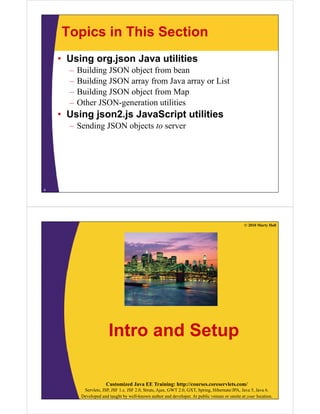
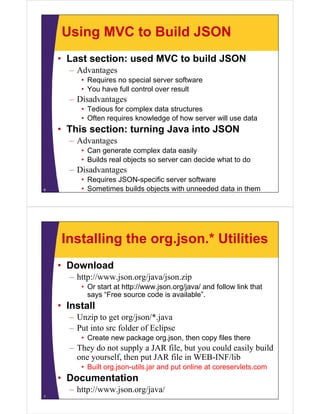
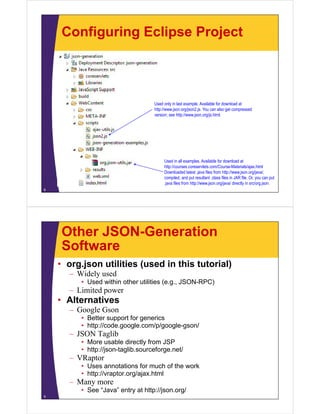

![Utilities for Finding Beans:
CityUtils.java
CityUtils java
• Map that associates city name with City
private static Map<String,City> biggestAmericanCities =
new HashMap<String,City>();
• Populate it with largest US cities
• L k
Lookup f
functions
ti
public static City getCity(String name) {
name = name.toUpperCase();
return(biggestAmericanCities.get(name));
}
12
Utilities for Finding Beans:
CityUtils.java
CityUtils java Continued
• Map that associates category of cities with
city names
i
private static Map<String,String[]> cityTypeMap;
• Lookup function
public static List<City> findCities(String cityType) {
String[] cityNames = cityTypeMap get(cityType);
cityTypeMap.get(cityType);
if (cityNames == null) {
String[] twoCities = { "New York", "Los Angeles" };
cityNames = twoCities;
}
List<City> cities = new ArrayList<City>();
for(String cityName: cityNames) {
cities.add(getCity(cityName));
cities add(getCity(cityName));
}
return(cities);
13 }](https://image.slidesharecdn.com/automatically-generating-json-from-java-objects-java-objects268-111030153141-phpapp01/85/Automatically-generating-json-from-java-objects-java-objects268-6-320.jpg)

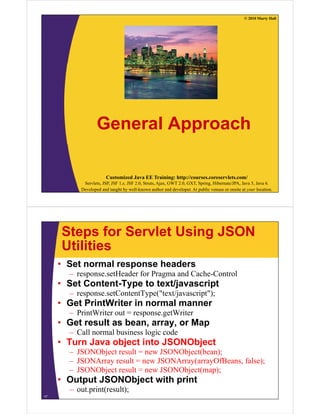

![Turning Beans into JSON
• org.json defines JSONObject
– I toString method builds JSON f
Its S i h d b ild format
• Most important constructor takes a bean
– JSONObject json = new JSONObject(myBean);
• Second arg of “true” means to include superclass info
– Result
• Uses reflection on myBean to find all public methods of the
form getBlah (any return type) or isBlah (boolean return)
• Calls each getter method
• If myBean has getFoo and getBar, it builds object of the
form { "foo": "getFoo() result", "bar": "getBar() result"}
• Other capabilities
– Can turn Map into JSONObject (keys become properties)
– Can add properties one at a time with “put”
20
JSONObject from Bean:
Example Code
package coreservlets;
import org.json.*;
public class CityTest1 {
public static void main(String[] args) {
City sf = CityUtils.getCity("San Francisco");
JSONObject fJSON
JSONObj t sfJSON = new JSONObj t( f)
JSONObject(sf);
System.out.println("JSON version of SF is:n" +
sfJSON);
}
}
Note: toString is automatically called when you print an
Object in Java. It is the toString method of JSONObject that
builds the JSON representation.
21](https://image.slidesharecdn.com/automatically-generating-json-from-java-objects-java-objects268-111030153141-phpapp01/85/Automatically-generating-json-from-java-objects-java-objects268-10-320.jpg)
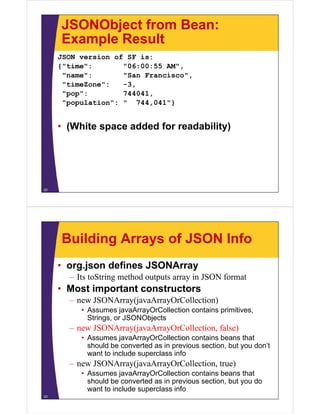
![JSONArray: Example Code
package coreservlets;
import org.json.*;
import java.util.*;
public class CityTest2 {
public static void main(String[] args) {
List<City> biggestUSCities =
CityUtils.findCities("top-5-cities");
JSONArray citiesJSON =
new JSONArray(biggestUSCities, false);
e JSO ay(b ggestUSC t es, a se);
System.out.println("JSON version of biggest " +
"US cities is:n" +
);
citiesJSON);
}
}
24
JSONArray: Example Result
JSON version of biggest US cities is:
[{"time":"09:14:16 AM" "name":"New York"
AM", York",
"timeZone":0,"pop":8250567,"population":"8,250,567"},
{"time":"06:14:16 AM", "name":"Los Angeles",
"timeZone":-3,"pop":3849368,"population":"3,849,368"},
"timeZone": 3 "pop":3849368 "population":"3 849 368"}
{"time":"08:14:16 AM", "name":"Chicago",
"timeZone":-1,"pop":2873326,"population":"2,873,326"},
{"time":"08:14:16 AM", "
{"ti " "08 14 16 AM" "name":"Houston",
" "H t "
"timeZone":-1,"pop":2144491,"population":"2,144,491"},
{"time":"07:14:16 AM", "name":"Phoenix",
"timeZone":-2,"pop":1512986,"population":"1,512,986"}]
"ti Z " 2 " " 1512986 " l ti " "1 512 986"}]
• (White space added for readability)
25](https://image.slidesharecdn.com/automatically-generating-json-from-java-objects-java-objects268-111030153141-phpapp01/85/Automatically-generating-json-from-java-objects-java-objects268-12-320.jpg)
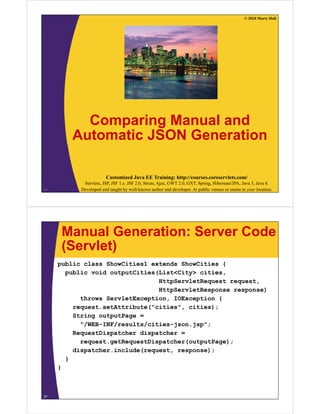
![Manual Generation: Server Code
(JSP)
{ headings: ["City", "Time", "Population"],
cities: [["${cities[0] name}" "${cities[0] time}"
[["${cities[0].name}", "${cities[0].time}",
"${cities[0].population}"],
["${cities[1].name}", "${cities[1].time}",
"${cities[1].population}"],
["${cities[2].name}", "${cities[2].time}",
"${cities[2].population}"],
["${cities[3].name}", "${cities[3].time}",
"${cities[3].population}"],
[ ${
["${cities[4].name}", "${cities[4].time}",
[ ] } , ${ [ ] } ,
"${cities[4].population}"]]
}
28
Manual Generation: Client Code
function cityTable1(address, inputField, resultRegion) {
var data = "cityType=" + getValue(inputField);
ajaxPost(address, data,
function(request) {
showCityInfo1(request,
showCityInfo1(request resultRegion);
});
}
• Note:
– ajaxPost shown in previous tutorial section
• Sends data via POST and passes result to handler
function
29](https://image.slidesharecdn.com/automatically-generating-json-from-java-objects-java-objects268-111030153141-phpapp01/85/Automatically-generating-json-from-java-objects-java-objects268-14-320.jpg)

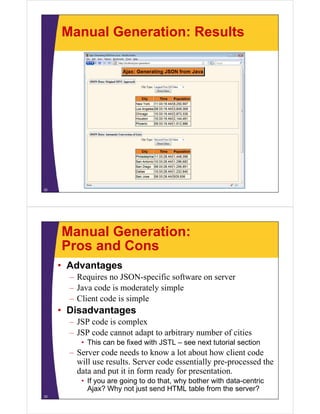

![Automatic Generation: Client
Code
function cityTable2(address, inputField, resultRegion) {
var data = "cityType=" + getValue(inputField);
ajaxPost(address, data,
function(request) {
showCityInfo2(request,
showCityInfo2(request resultRegion);
});
}
• Note:
– Only difference from previous example is that result is
passed to showCityInfo2 instead of ShowCityInfo1
36
Automatic Generation: Client
Code (Continued)
// Data that arrives is an array of city objects.
// City objects contain (among other things)
// name, time, and population properties.
function showCityInfo2(request, resultRegion) {
if ((request.readyState == 4) &&
(request.status == 200)) {
var rawData = request.responseText;
var cities = eval("(" + rawData + ")");
eval( ( ) );
var headings = ["City", "Time", "Population"];
var rows = new Array();
for(var i=0; i<cities.length; i++) {
var city = cities[i];
rows[i] = [city.name, city.time, city.population];
}
var t bl = getTable(headings, rows);
table tT bl (h di )
htmlInsert(resultRegion, table);
}
37
}](https://image.slidesharecdn.com/automatically-generating-json-from-java-objects-java-objects268-111030153141-phpapp01/85/Automatically-generating-json-from-java-objects-java-objects268-18-320.jpg)
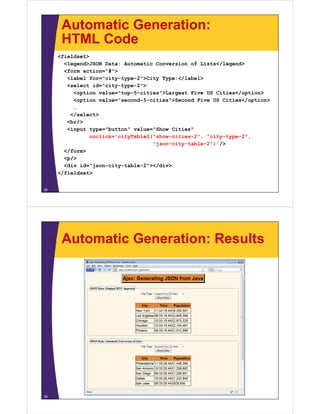
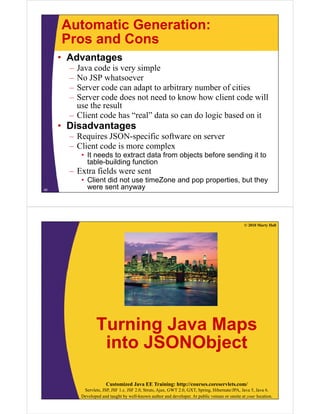
![Building JSONObject from Map
• Most important JSONObject constructors
– new JSONObject(bean)
• Uses reflection on myBean to find all public methods of the
form getBlah (any return type) or isBlah (boolean return)
g ( y yp ) ( )
• Calls each getter method
• If myBean has getFoo and getBar, it builds object of the
form { "foo": "getFoo() result , "bar": "getBar() result }
foo : getFoo() result", bar : getBar() result"}
– new JSONObject(bean, true)
• Same as above but includes inherited methods
• Oth constructors
Other t t
– new JSONObject(map)
• Map keys become JSON property names
– new JSONObject(string)
42
• Useful when passing JSON to the server
JSONObject from Map:
Example Code
package coreservlets;
import org.json.*;
import java.util.*;
public class CityTest3 {
public static void main(String[] args) {
Map<String,String[]> cities =
M <St i St i []> iti
CityUtils.getCityTypeMap();
JSONObject citiesJSON =
new JSONObject(cities);
( )
System.out.println("JSON version of map of " +
"US cities is:n" +
citiesJSON);
}
43 }](https://image.slidesharecdn.com/automatically-generating-json-from-java-objects-java-objects268-111030153141-phpapp01/85/Automatically-generating-json-from-java-objects-java-objects268-21-320.jpg)
![JSONObject from Map:
Example Result
JSON version of map of US cities is:
{ superbowl hosts :
{"superbowl-hosts":
["Phoenix","Miami",
"Detroit","Jacksonville","Houston"],
top 5 cities :
"top-5-cities":
["New York","Los Angeles",
"Chicago","Houston","Phoenix"],
cities starting with s :
"cities-starting-with-s":
["San Antonio","San Diego",
"San Jose","San Francisco","Seattle"],
seco d 5 c t es :
"second-5-cities":
["Philadelphia","San Antonio",
"San Diego","Dallas","San Jose"]}
• (White space added for readability)
44
Converting Maps: Server Code
public class ShowCityTypes extends HttpServlet {
public void doGet(HttpServletRequest request
request,
HttpServletResponse response)
throws ServletException, IOException {
response.setHeader( Cache Control
response setHeader("Cache-Control", "no-cache");
no cache );
response.setHeader("Pragma", "no-cache");
response.setContentType("text/javascript");
PrintWriter out = response.getWriter();
JSONObject cityTypes =
new JSONObject(CityUtils.getCityTypeMap());
out.p
out.println(cityTypes);
t (c ty ypes);
}
45](https://image.slidesharecdn.com/automatically-generating-json-from-java-objects-java-objects268-111030153141-phpapp01/85/Automatically-generating-json-from-java-objects-java-objects268-22-320.jpg)

![Converting Maps: Client Code
(Continued)
function showCityTypeInfo(request, resultRegion) {
if ((request.readyState == 4) &&
(request.status == 200)) {
var rawData = request.responseText;
var cityTypes = eval("(" + rawData + ")");
var headings = new Array();
Object property names are city
var row1Entries = new Array(); categories like “top-5-cities”
var i = 0;
for(var cityType in cityTypes) {
headings[i] = cityType;
row1Entries[i] = getBulletedList(cityTypes[cityType]);
i++;
}
var rows = [row1Entries];
var result = getTable(headings, rows); Object property values are
arrays of city names (
y y (cities
htmlInsert(resultRegion, result);
ht lI t( ltR i lt) that match the category)
}
}
48
Converting Maps: Client Code
(Continued)
function getBulletedList(listItems) {
var list = "<ul>n";
for(var i=0; i<listItems.length; i++) {
list = list + " <li>" + listItems[i] + "</li>n";
}
list = list + "</ul>"
return(list);
}
49](https://image.slidesharecdn.com/automatically-generating-json-from-java-objects-java-objects268-111030153141-phpapp01/85/Automatically-generating-json-from-java-objects-java-objects268-24-320.jpg)
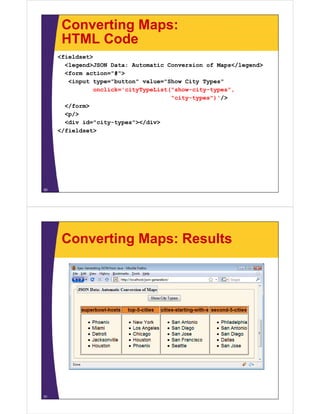
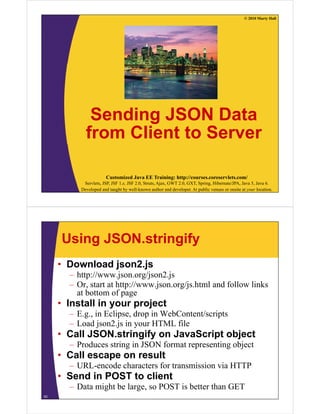

![Sending JSON to Server:
Client Code
function randomCityTable(address, resultRegion) {
var data = "cityNames=" +
cityNames=
makeJsonString(getRandomCities());
ajaxPost(address, data,
function(request) {
showCityInfo2(request, resultRegion);
});
}
This is the same showCityInfo2 function used earlier.
Takes an array of city objects and makes HTML table
from their names, times, and populations.
56
Sending JSON to Server:
Client Code (Continued)
var cityNames =
[ New York , Los Angeles", Chicago , Houston ,
["New York", "Los Angeles , "Chicago", "Houston",
"Phoenix", "Philadelphia", "San Antonio", "San Diego",
"Dallas", "San Jose", "Detroit", "Jacksonville",
"Indianapolis", "San Francisco", "Columbus", "Austin",
p , , , ,
"Memphis", "Fort Worth", "Baltimore", "Charlotte",
"El Paso", "Milwaukeee", "Boston", "Seattle",
"Washington DC", "Denver", "Louisville", "Las Vegas",
"Nashville", "Oklahoma City", "Miami"];
57](https://image.slidesharecdn.com/automatically-generating-json-from-java-objects-java-objects268-111030153141-phpapp01/85/Automatically-generating-json-from-java-objects-java-objects268-28-320.jpg)
![Sending JSON to Server:
Client Code (Continued)
function getRandomCities() {
var randomCities = new Array();
var j = 0;
for(var i=0; i<cityNames.length; i++) {
if(Math.random() < 0.25) {
( () )
randomCities[j++] = cityNames[i];
}
}
return(randomCities);
}
58
Sending JSON to Server:
HTML Code
<script src="./scripts/ajax-utils.js"
type text/javascript ></script>
type="text/javascript"></script>
<script src="./scripts/json-generation-examples.js"
type="text/javascript"></script>
<script src="./scripts/json2.js"
p p j j
type="text/javascript"></script>
…
<fieldset>
<legend>JSON Data: Sending JSON <i>to</i>
Server</legend>
<form action="#">
<input type="button" value="Show Random Cities"
onclick='randomCityTable("show-cities-3",
"json-city-table-3")'/>
</form>
<p/>
<div id="json-city-table-3"></div>
59 </fieldset>](https://image.slidesharecdn.com/automatically-generating-json-from-java-objects-java-objects268-111030153141-phpapp01/85/Automatically-generating-json-from-java-objects-java-objects268-29-320.jpg)
![Sending JSON to Server:
Server Code
public class ShowCities3 extends ShowCities {
p
protected List<City> getCities(HttpServletRequest request) {
y g ( p q q )
String cityNames = request.getParameter("cityNames");
if ((cityNames == null) || (cityNames.trim().equals(""))) {
cityNames = "['New York', 'Los Angeles]";
}
try {
JSONArray jsonCityNames = new JSONArray(cityNames);
List<City> c t es = new ArrayList<City>();
st C ty cities e ay st C ty ();
for(int i=0; i<jsonCityNames.length(); i++) {
City city =
CityUtils.getCityOrDefault(jsonCityNames.getString(i));
cities.add(city);
}
return(cities);
} catch(JSONException jse) {
return(CityUtils.findCities("top-5-cities"));
}
60
}
Sending JSON to Server:
Results
61](https://image.slidesharecdn.com/automatically-generating-json-from-java-objects-java-objects268-111030153141-phpapp01/85/Automatically-generating-json-from-java-objects-java-objects268-30-320.jpg)
